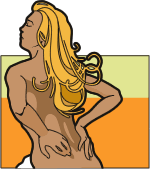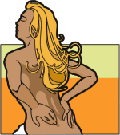
The concept of holistic health supports the idea that if a single part of an organism is damaged, the effect is not merely on that part, but on the whole. Likewise, any benefit to its parts is supportive of the entire organism. The theory of holism fundamentally treats causes, not just symptoms. In light of this model, we may conclude, for instance, that the use of commercial soaps, whose synthetic ingredients are toxic and stripping, are detrimental to the skin and to the entire body.
We can look to India’s ancient ayurvedic tradition of Abhyanga for a reasonable solution to this modern problem. Abhyanga is the Sanskrit word for an oil massage given to the entire body. It is most commonly performed with sesame oil. Although this daily ayurvedic routine takes only a minute or two, when it is performed habitually the results are multi-dimensional.
As you’d expect, the skin becomes more lustrous.
On a slightly deeper level, physical and psychological tensions are eased through the warmth of touch, even when it is our own.
Over time, we can begin to process our deepest patterns, because Abhyanga’s effect helps to gently ease them in to our conscious minds. With awareness, we can choose to resolve our negative karmas and resolve deep emotional issues. Gradually, the spirit is restored to its original state of freedom and lightness. Unencumbered, it flourishes and we evolve.
Overall, the Abhyanga is satisfying alone and fun as a couple. All you need to do is give in to its soothing effects and generally the rest will follow. Like many things yogic, the level of satisfaction and results derived from Abhyanga transcends language. Its value cannot be expressed fully in discussion; its benefit is purely experiential.
Technique:
Many massage therapist heat a bottle of oil in hot water. At home, you may opt for heating the oil by rubbing it between your hands. The warmed oil is rubbed onto the skin, using long strokes along the muscles and small circular stokes at the joints. Include the scalp if you intend to shampoo. The process is continued for few minutes until the whole body is oiled liberally and the circulation is stimulated. A hot shower or bath immediately follows, allowing the oil to penetrate with the aid of steam and hot water.
While bathing, use soap only on the bodily parts that you feel need thorough cleansing. This may seem to shrug Western standards for cleanliness, yet after trying it for just a week, you’ll become more sensitive to the various textures, secretions, and odors of the epidermis. Cleanse out of need, not habit. When appropriate, you may choose to cleanse first and then apply oil all over. Most likely, it will become evident that you do not need as much lathering as you thought.
Sources for Oil:
Sesame oil is the most common recommendation by ayurvedic texts.
Ordinary grocery store sesame oil is fine.
Organic oil packaged in glass is best. (Oil breaks down oil, so why chance absorbing even trace amounts of petroleum-based plastic?)
If you are of pitta constitution, you may opt for safflower oil instead, for its cooling properties.
Other vegetable oils such as grapeseed, jojoba, olive, almond, and sunflower are fine.
Never, ever use mineral oil! That is petroleum based.
Do not use the dark culinary “toasted’ sesame oil. It is much too pungent, and processing at high heat has diminished its beneficial properties.
If you have knowledge of the individual properties of essential oils, you can create your own blend. Personally, I work with one formula for a couple of months utilizing a few essential oils in a sesame oil base. The subtle properties of the essential oils I choose promote my conscious efforts for self-development.
I’ve been known to make custom blends for friends. If you are interested, email (orders@askyogimarlon.com) me 5 sentences maximum describing what issues you’re working on. I’ll send you a price quote before I make up a special formulation, because prices of appropriate essential oils vary widely.
Deepest Effects:
Abhyanga nourishes the skin, and gradually the tissues beneath. With habitual use of this technique, each of the dhatus is replenished. Dhatus are the 7 levels of bodily tissue that create the structure and make the functioning of bodily systems possible. They are:
- Rasa Dhatu: plasma, white blood cells and immune system
- Rakta Dhatu: red blood cells
- Mamsa Dhatu: muscle
- Meda Dhatu: fat tissue
- Asthi: bone and cartilage
- Majja: nervous system and bone marrow
- Shakra: male reproductive tract Or Artava: female reproductive tract
- Yogi Marlon
|




